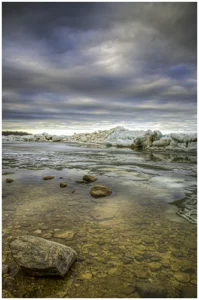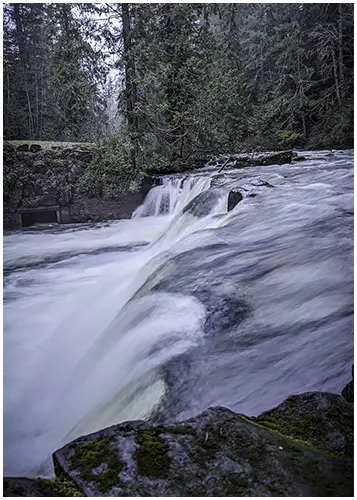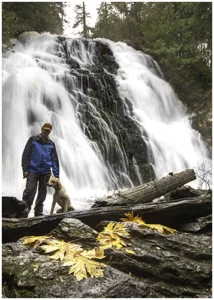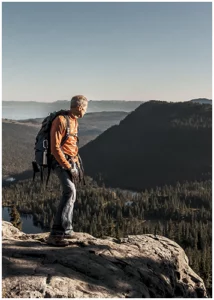
ON1 NoNoise AI Review: Eliminate Noise & Sharpen Your Photos
Are you tired of noise or grain messing up your photos? ON1 NoNoise AI could
Grand Opening & Black Friday Sale = 50% Off


Waterfalls are my muse. If it weren’t for waterfalls, I’m not sure if I’d be so amped about mastering the art of long-exposure waterfall photography. Let me help you elevate your images to breathtaking levels. With the right gear, skill, and creativity, you’ll capture the beauty and movement of waterfalls in a way that will amaze viewers. In this article, I share important skills, camera settings, equipment, and techniques to help you improve your waterfall photos.
There's no better place to find yourself than sitting by a waterfall and listening to its music
Roland R. Kemler
Silky is not milky, and yes, there is a difference, especially if you want to print your photos.
Long-exposure photography turns flowing water into a smooth, silky texture, giving your images a magical and dreamy look. To capture the beauty of flowing water and improve your waterfall photos, there are important skills to develop.
By improving these important skills, you’ll be able to take stunning long-exposure photos of water.
Early Black Friday Save up to 35% On Photo RAW – Download your free trial today!
Shutter speed and aperture are the two fundamental settings that play a crucial role in capturing stunning waterfall photos. Understanding how these settings work is essential to achieving the desired effects in long-exposure photography.
The shutter speed refers to the amount of time the camera’s shutter remains open. In waterfall photography, it determines the level of motion blur in your images. A slower shutter speed makes flowing water look silky and smooth, creating a beautiful, dreamy effect. This blurring effect adds a sense of movement and enhances the overall aesthetics of your photos.
On the other hand, if you want to freeze motion and capture the details of the water droplets, you can use a faster shutter speed.
Depending on the flow of the river, I'm always adjusting my shutter. Lately, I've been shooting at 1/4 sec. But if the water is rushing, I've been as high as 1/20th. The point is to not blow out the water.
Pro-Tip
Aperture controls the depth of field, which is the range of focus from the foreground to the background. Choose the right aperture setting for sharp focus when photographing waterfalls and the surrounding landscape. A wider aperture (lower f-stop like f/2.8) creates a shallower depth of field, focusing on a specific portion of the photo. This can be used creatively to highlight the waterfall while creating a pleasing background blur. Using a smaller aperture, such as f/16, will make the waterfall and surrounding elements look sharp and clear.
You need to master these camera settings to control motion in your long-exposure waterfall photography.
Look at the falls; if the falls are the main subject, filling the frame with an F/22 really doesn't matter. Think about the focus plane.
Pro-Tip
To achieve the stunning effects of long-exposure waterfall photography, there are essential items that you cannot do without.
A tripod is an essential piece of gear for waterfall photography, as it provides stability for long-exposure photos. When choosing a tripod, consider factors such as weight, height, and durability. Find a strong tripod made of carbon fibre or aluminium that can handle the weight of your camera and lenses. Make sure the tripod is tall enough, compact, and lightweight for easy transportation. I’ve had my tripod for well over 15 years, so investing in a high-quality tripod is a no-brainer. With the cost of a lens and camera, a good tripod should not set you back more than a few hundred dollars.
ND filters are important for taking photos of waterfalls with long exposures in bright light. They help create smooth water effects in the photos. ND filters reduce the amount of light that enters the lens without affecting colour or contrast. Use ND filters to make your shutter speed slower.
Neutral Density Filters come in different strengths, and they are measured in stops, such as 3, 6, or 10-stop filters. Experimenting with different filter strengths will help you achieve the desired effect in various lighting conditions. Again, yes, they are a few hundred dollars for a good one, but you only need to purchase them once. Invest in high-quality ND filters; you shouldn’t see a colour cast when using them.
When you’re photographing a waterfall, using a polarizer can make a big difference in your final picture. Here’s why:
Black Friday deals on now! Save up to 77% – Plus an additional 10% when you use code bwild10
To capture long-exposure waterfall photography, you need to understand the technical aspects. However, don’t forget to consider composition and camera settings as well.
When composing your photo, consider using the rule of thirds to create a balanced and visually pleasing image. To capture landscape photos, divide your frame into nine equal parts using two horizontal and two vertical lines. Sometimes, using a tripod can be helpful for this. the main elements of your composition, such as the waterfall or prominent rocks, along these lines or at their intersections.
Another effective composition technique is including leading lines in your frame. Leading lines can be rivers or man-made structures, like pathways or tree trunks, that guide the viewer’s eye to the waterfall. These lines add depth and guide the viewer’s attention to the main subject.
If you find auto-focus starts to hunt, IE move back and forth, switch to manual focus. Most cameras have a magnification feature that allows you to zoom in and fine-tune the focus on the waterfall.
Choosing the right camera settings is crucial for capturing stunning long exposure photography. Here’s a look at the key settings you need to consider:
Try different combinations of settings to find the right balance and achieve the effect you want in your waterfall photos. Practice makes perfect, so don’t be afraid to try different settings and techniques to refine your skills.
After mastering long-exposure waterfall photography basics, you can take your shots to the next level by trying advanced techniques. Use these techniques to expand your creativity.
One advanced technique is using wider angles in your compositions. Sometimes, capturing a wider field of view creates dramatic perspectives in the photos. This helps the overall composition by adding depth and context to the main subject.
To achieve this, try using a wide-angle lens or zooming out to capture a broader scene. Position yourself at a vantage point where you can capture both the waterfall and its surroundings in a single frame. Experiment with different angles and compositions to find the most visually appealing perspective.
I invested 30 minutes during one of my recent photo sessions to carefully position a series of rocks at the top of the waterfall to create striking leading lines in the photo.
Pro-Tip
Another advanced technique to explore is exposure bracketing and blending. This technique involves taking multiple shots of the same scene with different exposure settings and then merging them during post-processing. Exposure bracketing, or HDR, helps capture a wider range of light, ensuring that all details are properly exposed in the final image.
To use exposure bracketing, set your camera to shoot in auto-bracketing mode or manually adjust the exposure settings between shots. Take a series of photos, varying the exposure values by one or two stops between each shot. After shooting an odd number of different exposures, you combine them using specialized software like Skylum Neo HDR (High Dynamic Range) processing.
This blending process will help you create a better-exposed photo with well-exposed highlights and shadows throughout. It can make your long exposure photography more dynamic.
Be careful! HDR has been overused for years, and if not done correctly, you can very easily create ghastly photos.
Pro-Tip
Timing and location play a critical role in capturing inspiring photos. Carefully choosing the right time of year is essential for waterfall photography. Overcast days can be your best friend.
On overcast days, the soft and diffused light provides ideal conditions for waterfall photography. The absence of harsh shadows allows for a more balanced exposure. The subdued lighting also helps to avoid overexposure in bright areas, ensuring a well-exposed image.
Each season offers a unique opportunity. In spring, vibrant foliage and new growth can provide a burst of colour and freshness, as well as higher water flow. Summer offers lush greenery perfect for landscape photography, creating dynamic and powerful compositions. Fall showcases autumn colours, adding warmth and depth to your photographs. Winter brings a sense of tranquilly and captures the magical beauty of frozen waterfalls.
Exploring waterfalls in different seasons can capture the varying beauty of nature and create a diverse portfolio of stunning images.
When photographing waterfalls, it’s crucial to take proactive measures to protect your camera equipment from the elements. Shooting near water puts your gear at risk of water damage, which can be costly and inconvenient. By implementing preventive measures, you can safeguard your equipment and focus on photographing waterfalls without worrying about potential damage.
One of the primary concerns when shooting near waterfalls is keeping your equipment dry. Water damage can occur if you’re not careful, so it’s essential to take the necessary steps to protect your gear.
Here are some tips:
Another challenge when photographing waterfalls is managing mist and water droplets that can accumulate on your lens. These can lead to unwanted artifacts in your images if not addressed properly. Here are some helpful techniques to keep your lens clear:
By following these tips, you can safeguard your camera and lens from water damage and efficiently address mist and water droplets on your lens. This allows you to focus on capturing stunning images and ensures the longevity of your gear.
After capturing breathtaking waterfall photos, the next step is post-processing to enhance the visual impact of your images. Post-processing enhances the details and colours of your photos, making them even more stunning. Here are some valuable editing tips that will help you bring out the best in your waterfall images.
To emphasize the flowing water and create a dreamy atmosphere, decrease the exposure slightly to darken the overall image and bring out the water’s silky texture. Increase the contrast to enhance the difference between highlights and shadows, adding depth to the waterfall. Lastly, dodge and burn the edges around the waterfall.
These small adjustments can make a big difference in enhancing the silky water effect.
To make your waterfall images truly pop, focus on bringing out the details and colours. Start by adjusting the saturation and vibrance levels to enhance the richness and intensity of the colours present in the photo. Be careful not to overdo it, as too much saturation can make the image appear unnatural. Next, use selective editing techniques to highlight specific areas or elements in the photo. This can be useful for accentuating details in the waterfall or the surrounding foliage.
By mastering the art of post-processing, you have the power to transform your waterfall photographs into stunning visual masterpieces. When editing your photos, try different techniques, but stay true to your vision and preserve the natural beauty of the moving water. With practice and creativity, you’ll be able to create captivating waterfall images that leave a lasting impression on viewers.
Ready to capture the silky magic of waterfalls? Long-exposure photography is your ticket! Remember, practice and patience are your best tools. Begin with the basics. sturdy tripod, the right settings, and with a bit of experimentation, you’ll master those dreamy, flowy shots. Advanced shutterbugs refine your craft by tackling spray and motion blur. Dive in, learn from every click, and let the inspiration flow. Your waterfall masterpieces await! Keep snapping, and let that shutter slowly dance with the cascading water. Happy shooting!
To get the long exposure effect you want, use a low ISO, a small aperture for more depth, and a slow shutter speed to capture water motion. Adjustments may be needed depending on the lighting conditions and desired effect.
To get the silky water effect, use a slower shutter speed, up to one second, depending on the water flow. This will create the desired blurred and smooth effect in the water.
Consider using the rule of thirds, leading lines, and different angles to compose your waterfall photos. Placing the waterfall off-centre and adding natural elements like rocks or foliage can make the composition more visually appealing and dynamic.
Try using wider angles to capture more of the surrounding environment, taking multiple exposures to capture a wider range of light, and blending the exposures for a more balanced final image.t

Are you tired of noise or grain messing up your photos? ON1 NoNoise AI could

Every time I get ready to photograph a waterfall, I feel a rush of excitement.

If you’re looking for an easy hike, well… this hike is not it! Most of